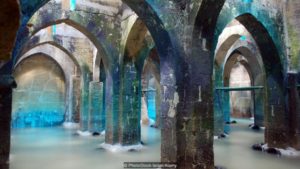 “Archaeologists believe this cistern is the first known use in the Arab world of the pointed arch, which eventually became a defining characteristic of Islamic architecture. These arches ‘freed architects both to raise their structures and also leave them spacious and airy,’” (BBC Travel, 9 March 2017).
“Archaeologists believe this cistern is the first known use in the Arab world of the pointed arch, which eventually became a defining characteristic of Islamic architecture. These arches ‘freed architects both to raise their structures and also leave them spacious and airy,’” (BBC Travel, 9 March 2017).
Ramla was a meeting place for east and west and its pointed arches – two pillars “leaning” on one another – can be taken as a symbol of Islam meeting Christianity and the positive influence of the one on the other. The pointed arch originated in Persia and as its strength became better known it was adopted all over medieval Europe to build soaring cathedrals.
This simple architectural device symbolises the fact that we need each other. We live in a time when Muslims are suspicious and fearful of the Christian or post- Christian world. It was not always like that. We used to live together and share each other’s discoveries. Our numbering system – 12345 – comes from the Muslim world, as does much else. The texts of Aristotle, which influenced much medieval and modern philosophy and theology, were preserved by the Muslims.
It is crazy that we live in fear of one another when we should be “leaning” on one another so that together we can lift up our struggling world which aches for justice and respect. Even a family can be seen as pointed arch! The mother “leans” on the father and the husband on the wife. Together they support their family – and enable each one to grow.
In Lent, promise and suffering “lean” on one another and support a person on their journey to the fullness of life. In this second week we have the story of the promise to Abraham who is to “leave your country.” A glimpse of where he, and all of us who call him “our father in faith”, will eventually arrive is given in the manifestation of Jesus in glory on the mountain. The climax of the Abraham story is the sacrifice of Isaac, his son, on another mountain. And the climax of Jesus’ mission was his death on Calvary. Jesus links Calvary with the scene the disciples witnessed on the mountain. “Tell no one about the vision until the Son of Man has risen from the dead.” Then they will understand.
So, joy “leans” on suffering and we sometimes attend funerals where we do not know whether to rejoice or weep. Our joy is laced though with suffering and our suffering is bursting forth with Jesus from the tomb. Both are always present if we can but notice. Neither stands alone. An isolated pillar will soon fall.
12 March 2017 Lent 2 A Genesis 12: 1-4 2 Timothy 1:8-10 Matthew 17:1-9
Post published in: Faith

